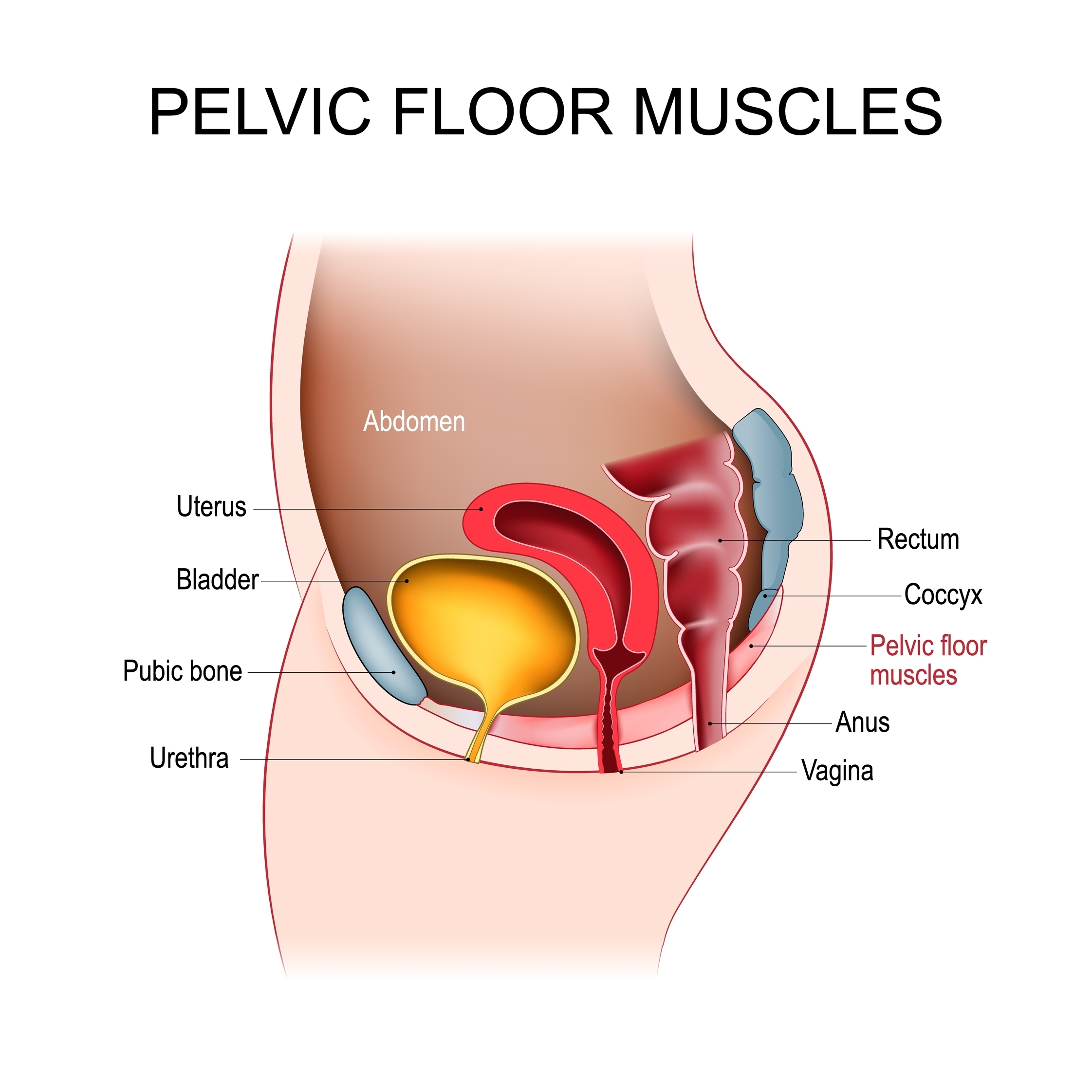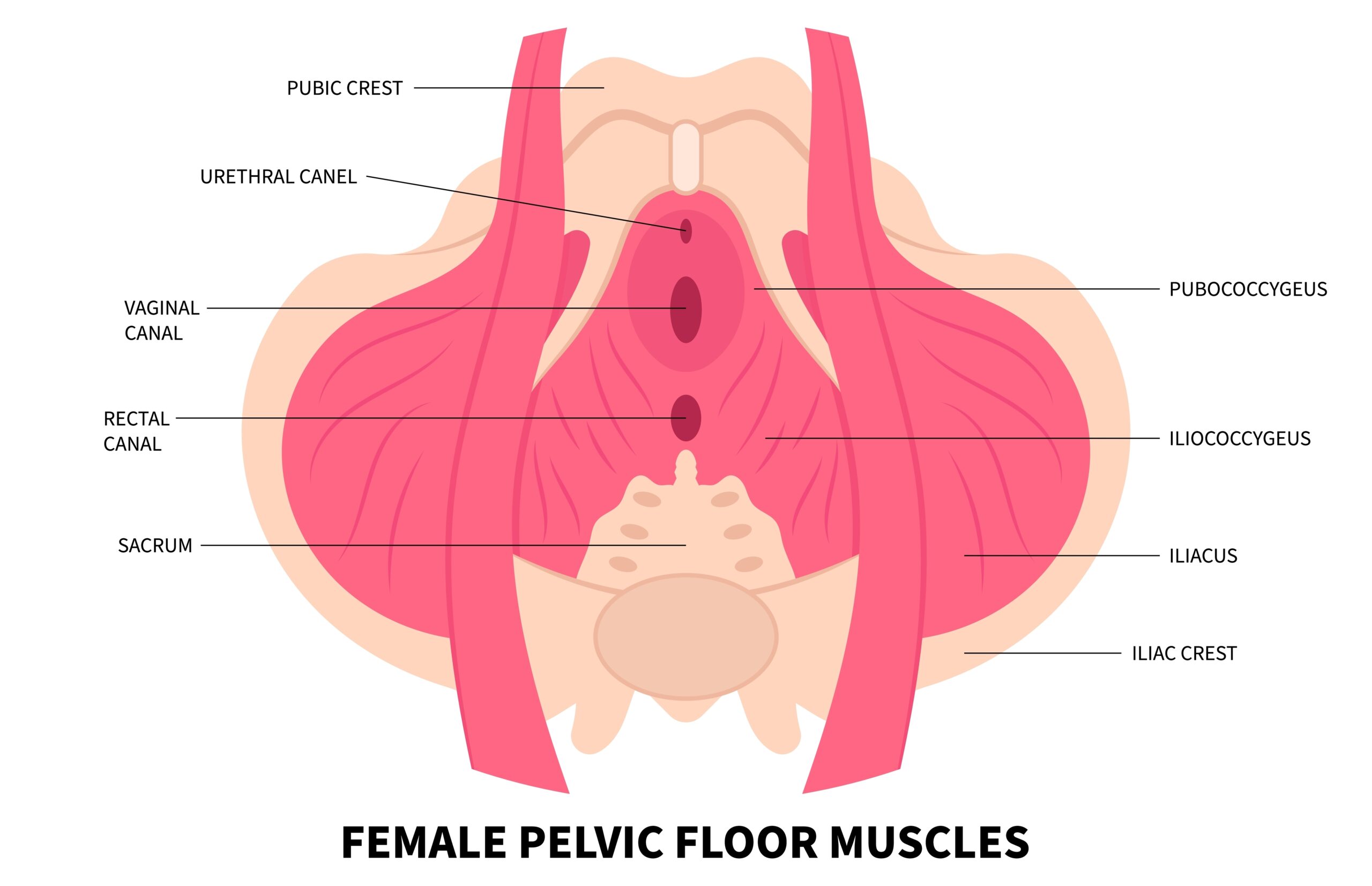As a physiotherapist working in Women’s, Men’s and Pelvic health for more than 20 years, pelvic floor exercises (also known as Kegel exercises) are a key part of treatment for my patients. These exercises might sound simple, yet it is surprising how many people find them difficult. This is especially the case if the muscles are weak. The first step to assist in doing these exercises correctly is to understand where the muscles are and what they do.
Understanding the Pelvic Floor
The pelvic floor consists of muscles, ligaments, and connective tissues that support the bladder, uterus (in women), and bowel. These muscles act like a hammock, providing support to the pelvic organs and maintaining continence. Factors such as pregnancy, childbirth, aging, and even certain medical conditions can weaken the pelvic floor muscles, leading to issues like urinary incontinence and pelvic organ prolapse.

Picture of the pelvic floor from the side

Picture of the female pelvic floor muscles from above
The Benefits of Pelvic Floor Exercises
Engaging in regular pelvic floor exercises offers numerous benefits:
1. Improved Continence: Strengthening these muscles can reduce or even eliminate urinary incontinence (also known as light bladder leakage). This is a common issue particularly after childbirth or during menopause.
2. Reduce symptoms of Pelvic Organ Prolapse: Strong pelvic floor muscles help to support the pelvic organs. For women who experience prolapse – the sensation of something coming down into the vagina – strengthening the pelvic floor muscles can significantly reduce that feeling.
3. Postpartum Recovery: For women who have recently given birth, pelvic floor exercises aid in the recovery of pelvic muscle tone and strength thus reducing the likelihood of incontinence or prolapse in the future.
4. Support During Menopause: Menopausal women often experience changes in pelvic floor health due to hormonal shifts. Regular exercises can help maintain pelvic floor strength as well as reduce symptoms such as vaginal dryness and discomfort with intercourse.
How to Perform Pelvic Floor Exercises
**Important note: Those who have urinary urgency or pain in the pelvic or vaginal region should seek help from a Women’s Health Physiotherapist for advice on correctly performing their exercises as often they need to learn to relax the muscles rather than strengthen.
Performing pelvic floor exercises correctly is crucial for effectiveness. Follow these steps:
1. Identify the Muscles: The first step is to correctly identify your pelvic floor muscles. Imagine stopping the flow of urine midstream or tightening the muscles you would use to prevent passing gas.
2. Exercise Technique: Once identified, contract these muscles and hold for up to 10 seconds (or as long as you can manage), then relax for 6 seconds. Repeat this cycle 10 times per session, aiming for 3 sessions a day. Relaxing the muscles is just as important as holding.
3. Consistency is Key: Like any exercise routine, consistency is crucial. Incorporate pelvic floor exercises into your daily routine, such as while brushing your teeth or waiting at a traffic light.
4. Progression: As your muscles strengthen, gradually increase the duration of each contraction and the number of repetitions. However, avoid overexertion or holding your breath during exercises.
Who should do Kegel exercises?
• Women or men who experience urinary incontinence.
• Women who are pregnant or have recently had a baby – best done with the guidance of a women’s health physiotherapist to learn to do the exercises correctly and progress in line with individual recovery
• Women who have symptoms of pelvic organ prolapse
• Women who are peri or postmenopausal. The muscles can start to weaken after this phase of life so, as with the rest of the body, it is a case of use it or lose it.
• Men who have had (or are going to have) a prostatectomy for prostate cancer.
Consult a Professional
If you just tried your pelvic floor exercises following the instructions above and you’re unsure whether you did them correctly, consult with a physiotherapist with expertise in pelvic health. If you have any of the symptoms we have discussed, a consultation with a pelvic health physiotherapist is valuable as there is more than just pelvic floor exercises that can help you on the road to recovery.
We have four highly-trained and experienced Women’s, Men’s and Pelvic Health physiotherapists at Total Physiotherapy. They can assess your condition, provide personalised guidance, and ensure you’re performing exercises correctly.
Don’t delay—start your journey to a stronger pelvic floor today by contacting Total Physiotherapy on 02 9907 0321 or visit www.totalphysiotherapymv.com.
By Louise Henderson
APA Titled Physiotherapist (Continence and Women’s Health)


